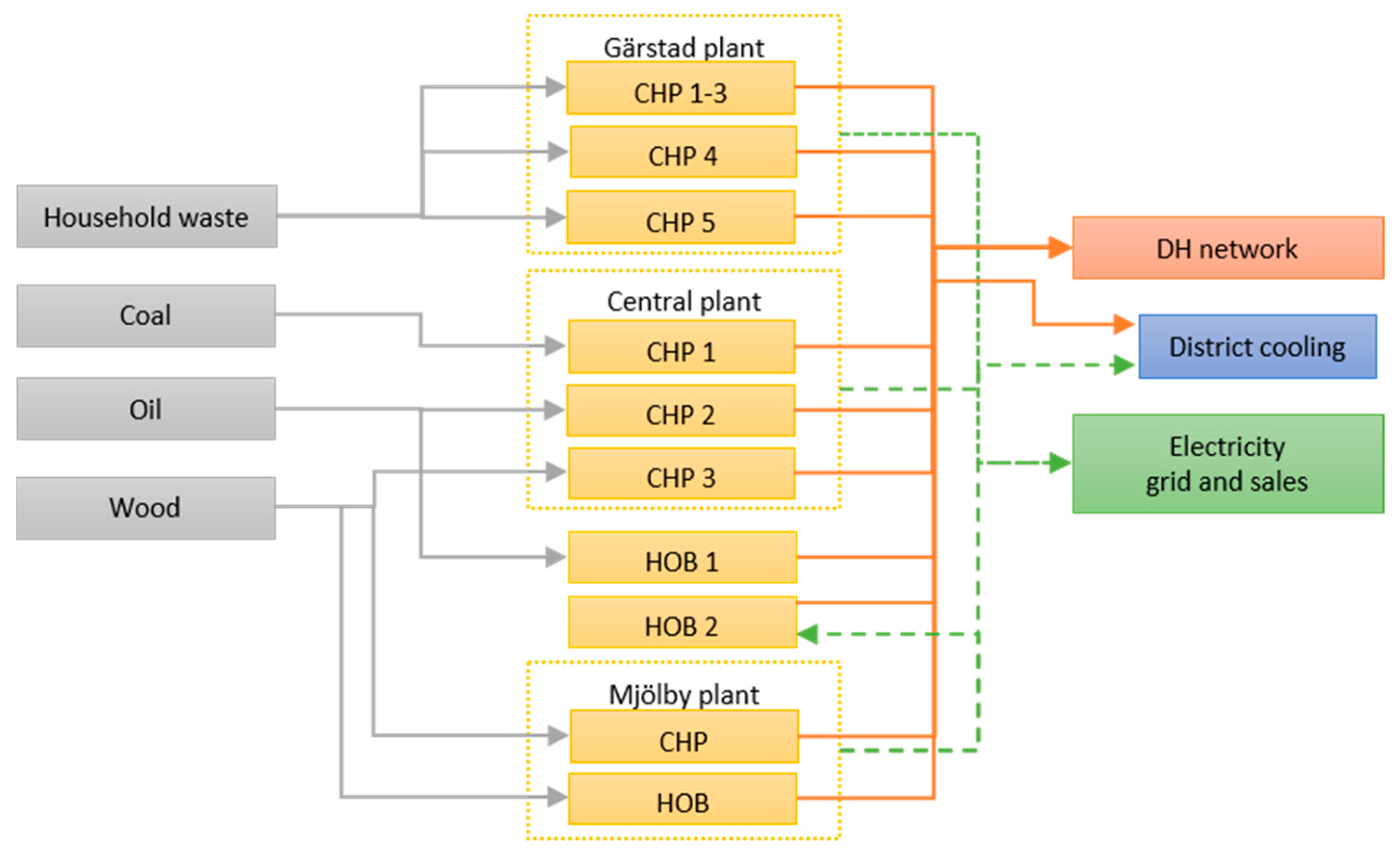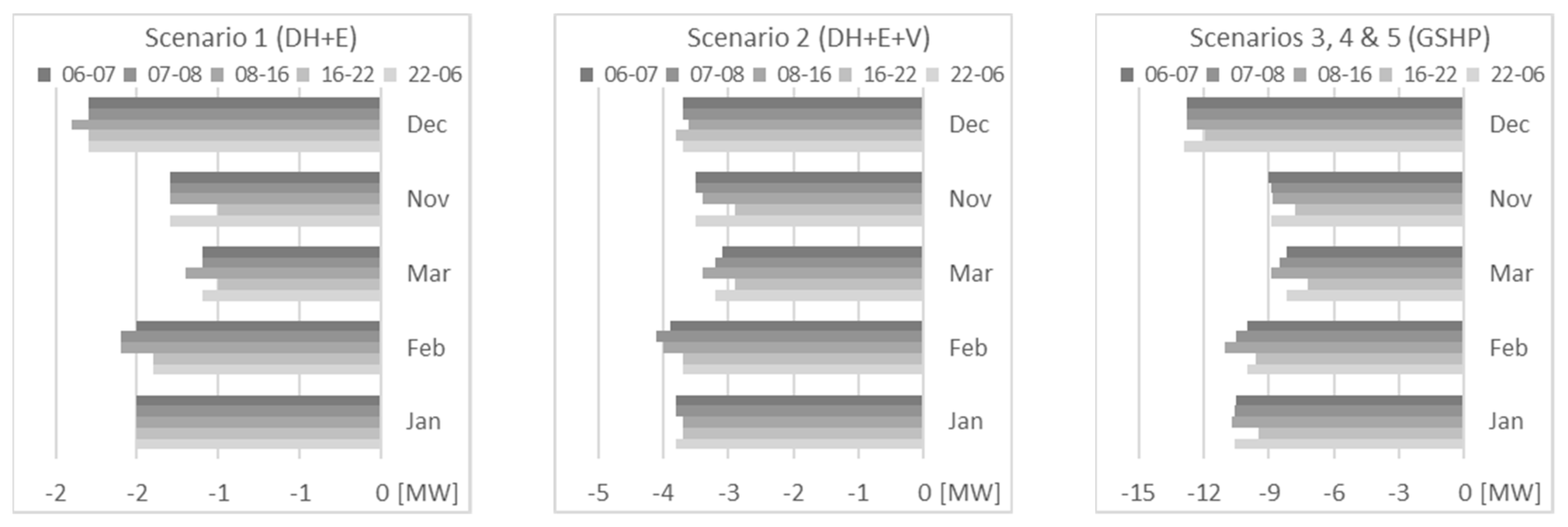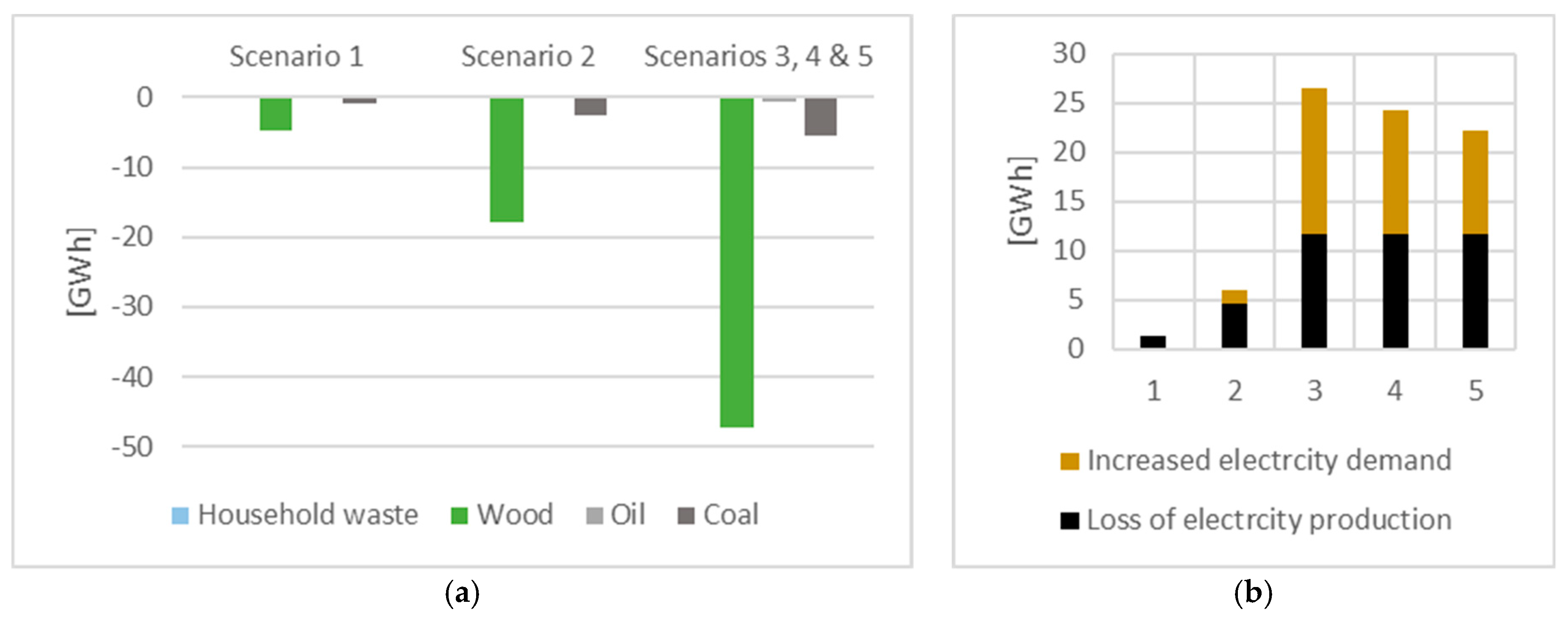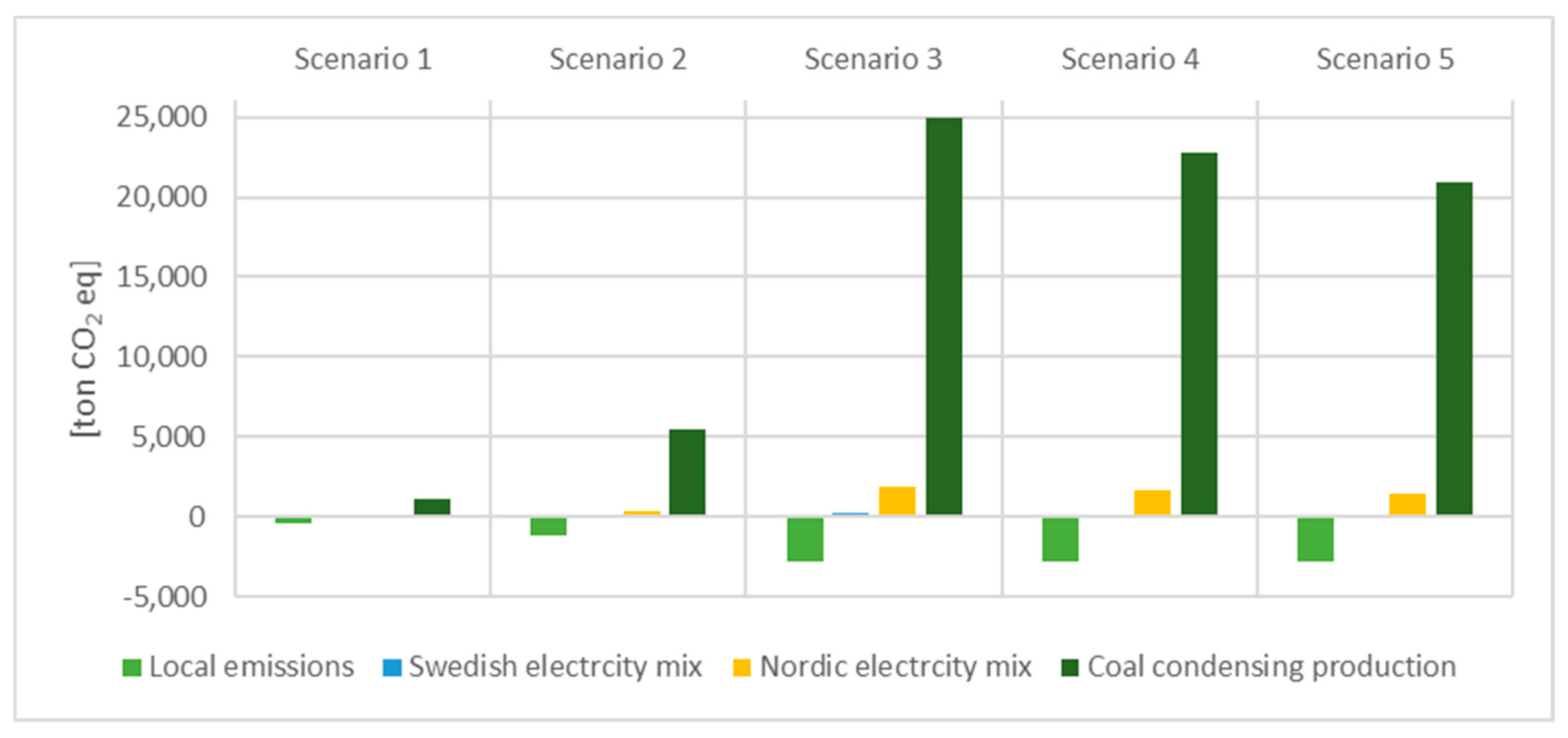The Impact on System Performance When Renovating a Multifamily Building Stock in a District Heated Region
Abstract
1. Introduction
2. Method
2.1. Building Energy Simulation
2.2. Optimization of the District Heating and Cooling System
3. The Scenario Study
3.1. The Reference Building and Renovation Scenarios
3.2. The DHC System
4. Results
4.1. Specific Energy Use and Energy Performance
4.2. Primary Energy Savings, Peak Power Demand, and Electricity Production
4.3. Local and Global GHG Emissions
5. Discussion
6. Conclusions
- All scenarios generate improved energy performance of the studied building, ranging from 11% to 56%, including both DH and GSHP heating solutions. Envelope measures have limited potential, while including ventilation measures, especially in combination with DH, generates a larger improvement.
- Scenarios utilizing GSHP for space heating and hot water demand show the best energy performance when calculating in accordance with the Swedish National Board of Housing, Building and Planning. However, the scenarios with GSHP also cause the significantly larger negative effect on GHG emissions, relative to scenarios utilizing DH.
- The peak power demand and, subsequently, the maximum capacity in the DHC system are reduced in all scenarios, ranging between 1 MW and 13 MW in the upscaled building stock or 4–48 W/m2 heated area.
- In a future fossil-free DHC system, a reduction in primary energy use will lead to a local reduction of emissions along with a positive effect on the global GHG emissions. This will lead to efficiency measures including DH out-performing measures with heat pump solutions.
Author Contributions
Funding
Acknowledgments
Conflicts of Interest
References
- Swedish Energy Agency. Energiläget 2018—En Översikt; Swedish Energy Agency: Eskilstuna, Sweden, 2018. [Google Scholar]
- The Swedish Environmental Protection Agency (Sv: Naturvårdsverket) Territorial Emissions and Uptake of Greenhouse Gases (Sv: Nationella Utsläpp och Upptag av Växthusgaser). Available online: http://www.naturvardsverket.se/Sa-mar-miljon/Statistik-A-O/Vaxthusgaser-territoriella-utslapp-och-upptag/? (accessed on 7 February 2019).
- Swedish Energy Agency. Energy in Sweden Facts and Figures 2018; Swedish Energy Agency: Eskilstuna, Sweden, 2018. [Google Scholar]
- Werner, S. District heating and cooling in Sweden. Energy 2017, 126, 419–429. [Google Scholar] [CrossRef]
- Meijer, F.; Itard, L.; Sunikka-Blank, M. Comparing European residential building stocks: performance, renovation and policy opportunities. Build. Res. Inf. 2009, 37, 533–551. [Google Scholar] [CrossRef]
- Statistics Sweden (Sv: Statistiska Centralbyrån (SCB)) Housing, Construction and Buildingr—Dwelling Stock. Available online: http://www.scb.se/bo0104-en (accessed on 7 February 2019).
- Hall, T.; Vidén, S. The Million Homes Programme: a review of the great Swedish planning project. Plan. Perspect. 2005, 20, 301–328. [Google Scholar] [CrossRef]
- Johansson, T.; Olofsson, T.; Mangold, M. Development of an energy atlas for renovation of the multifamily building stock in Sweden. Appl. Energy 2017, 203, 723–736. [Google Scholar] [CrossRef]
- Boverket och Energimyndigheten. Basis for the Second National Strategy for Energy Efficient Renovation (sv: Underlag Till Den Andra Nationella Strategin för Energieffektiviserande Renovering); Boverket och Energimyndigheten: Karlskrona, Sweden, 2016. [Google Scholar]
- Commission of the European Communities. 20 20 by 2020 Europe’s Climate Change Opportunity; Commission of the European Communities: Brussels, Belgium, 2008. [Google Scholar]
- Reinfeldt, F.; Olofsson, M. Prop. 2008/09:163: En sammanhållen klimat- och energipolitik; Government Office: Stockholm, Sweden, 2008.
- Löfven, S.; Baylan, I. Prop. 2017/18:228: Energipolitikens inriktning; Government Office: Stockholm, Sweden, 2018.
- Svenfelt, Å.; Engström, R.; Svane, Ö. Decreasing energy use in buildings by 50% by 2050—A backcasting study using stakeholder groups. Technol. Forecast. Soc. Chang. 2011, 78, 785–796. [Google Scholar] [CrossRef]
- Hong, T.; Koo, C.; Kim, J.; Lee, M.; Jeong, K. A review on sustainable construction management strategies for monitoring, diagnosing, and retrofitting the building’s dynamic energy performance: Focused on the operation and maintenance phase. Appl. Energy 2015, 155, 671–707. [Google Scholar] [CrossRef]
- Carli, R.; Dotoli, M. Cooperative Distributed Control for the Energy Scheduling of Smart Homes with Shared Energy Storage and Renewable Energy Source. IFAC-PapersOnLine 2017, 50, 8867–8872. [Google Scholar] [CrossRef]
- Parra, D.; Swierczynski, M.; Stroe, D.I.; Norman, S.A.; Abdon, A.; Worlitschek, J.; O’Doherty, T.; Rodrigues, L.; Gillott, M.; Zhang, X.; et al. An interdisciplinary review of energy storage for communities: Challenges and perspectives. Renew. Sustain. Energy Rev. 2017, 79, 730–749. [Google Scholar] [CrossRef]
- Parra, D.; Norman, S.A.; Walker, G.S.; Gillott, M. Optimum community energy storage system for demand load shifting. Appl. Energy 2016, 174, 130–143. [Google Scholar] [CrossRef]
- Kim, H.-J.; Yu, J.-J.; Yoo, S.-H.; Kim, H.-J.; Yu, J.-J.; Yoo, S.-H. Does Combined Heat and Power Play the Role of a Bridge in Energy Transition? Evidence from a Cross-Country Analysis. Sustainability 2019, 11, 1035. [Google Scholar] [CrossRef]
- Lake, A.; Rezaie, B.; Beyerlein, S. Review of district heating and cooling systems for a sustainable future. Renew. Sustain. Energy Rev. 2017, 67, 417–425. [Google Scholar] [CrossRef]
- Sayegh, M.A.; Danielewicz, J.; Nannou, T.; Miniewicz, M.; Jadwiszczak, P.; Piekarska, K.; Jouhara, H. Trends of European research and development in district heating technologies. Renew. Sustain. Energy Rev. 2016, 68, 1183–1192. [Google Scholar] [CrossRef]
- Lund, R.; Mathiesen, B.V. Large combined heat and power plants in sustainable energy systems. Appl. Energy 2015, 142, 389–395. [Google Scholar] [CrossRef]
- Werner, S. International review of district heating and cooling. Energy 2017, 137, 617–631. [Google Scholar] [CrossRef]
- Stankeviciute, L.; Krook Riekkola, A. Assessing the development of combined heat and power generation in the EU. Int. J. Energy Sect. Manag. 2014, 8, 76–99. [Google Scholar] [CrossRef]
- Sernhed, K.; Lygnerud, K.; Werner, S. Synthesis of recent Swedish district heating research. Energy 2018, 151, 126–132. [Google Scholar] [CrossRef]
- Helin, K.; Zakeri, B.; Syri, S.; Helin, K.; Zakeri, B.; Syri, S. Is District Heating Combined Heat and Power at Risk in the Nordic Area?—An Electricity Market Perspective. Energies 2018, 11, 1256. [Google Scholar] [CrossRef]
- Swedish Energy Agency. Short Term Prognosis, Summer 2018; Swedish Energy Agency: Eskilstuna, Sweden, 2018. [Google Scholar]
- Swedish Energy Agency. Scenarios of Sweden’s Energy System (sv: Scenarier Över Sveriges Energisystem); Swedish Energy Agency: Eskilstuna, Sweden, 2017. [Google Scholar]
- Churchman, C.W. The Systems Approach; Delacorte Press: New York, NY, USA, 1968; ISBN 9780440584599. [Google Scholar]
- Bijker, W.E.; Hughes, T.P.; Pinch, T. The Social Construction of Technological Systems: New Directions in the Sociology and History of Technology; MIT Press: Cambridge, MA, USA, 1987; ISBN 0262521377. [Google Scholar]
- Olsson, M.-O.; Sjostedt, G. Systems Approaches and Their Application: Examples from Sweden; Kluwer Academic Publishers: Dordrecht, The Netherlands, 2004; ISBN 1402023693. [Google Scholar]
- Meadows, D.H.; Wright, D. Thinking in Systems: A Primer; Chelsea Green Publishing: Burlington, VT, USA, 2008; ISBN 9781603580557. [Google Scholar]
- Ramírez-Villegas, R.; Eriksson, O.; Olofsson, T. Assessment of renovation measures for a dwelling area—Impacts on energy efficiency and building certification. Build. Environ. 2016, 97, 26–33. [Google Scholar] [CrossRef]
- Lidberg, T.; Olofsson, T.; Trygg, L. System impact of energy efficient building refurbishment within a district heated region. Energy 2016, 106, 45–53. [Google Scholar] [CrossRef]
- Abdurafikov, R.; Grahn, E.; Kannari, L.; Ypyä, J.; Kaukonen, S.; Heimonen, I.; Paiho, S. An analysis of heating energy scenarios of a Finnish case district. Sustain. Cities Soc. 2017, 32, 56–66. [Google Scholar] [CrossRef]
- Rinne, S.; Syri, S. Heat pumps versus combined heat and power production as CO2 reduction measures in Finland. Energy 2013, 57, 308–318. [Google Scholar] [CrossRef]
- Reino, A.; Harm, M.; Hamburg, A. The impact of building renovation with heat pumps to competitiveness of district heating: Estonian district heating pricing system needs more flexibility. In Proceedings of the 2017 IEEE 58th International Scientific Conference on Power and Electrical Engineering of Riga Technical University (RTUCON), Riga, Latvia, 12–13 October 2017; pp. 1–6. [Google Scholar]
- Traaen, K.B. Bergvarmepumper: Lokale Eller Kollektive Energibrønner? Norwegian University of Life Sciences: Ås, Norway, 2018. [Google Scholar]
- Reda, F.; Fatima, Z. Northern European nearly zero energy building concepts for apartment buildings using integrated solar technologies and dynamic occupancy profile: Focus on Finland and other Northern European countries. Appl. Energy 2019, 237, 598–617. [Google Scholar] [CrossRef]
- Heinonen, J.; Laine, J.; Pluuman, K.; Säynäjoki, E.-S.; Soukka, R.; Junnila, S.; Heinonen, J.; Laine, J.; Pluuman, K.; Säynäjoki, E.-S.; et al. Planning for a Low Carbon Future? Comparing Heat Pumps and Cogeneration as the Energy System Options for a New Residential Area. Energies 2015, 8, 9137–9154. [Google Scholar] [CrossRef]
- Le Truong, N.; Dodoo, A.; Gustavsson, L. Effects of energy efficiency measures in district-heated buildings on energy supply. Energy 2018, 142, 1114–1127. [Google Scholar] [CrossRef]
- Difs, K.; Bennstam, M.; Trygg, L.; Nordenstam, L. Energy conservation measures in buildings heated by district heating- A local energy system perspective. Energy 2010, 35, 3194–3203. [Google Scholar] [CrossRef]
- Djuric Ilic, D.; Dotzauer, E.; Trygg, L.; Broman, G. Introduction of large-scale biofuel production in a district heating system- an opportunity for reduction of global greenhouse gas emissions. J. Clean. Prod. 2014, 64, 552–561. [Google Scholar] [CrossRef]
- Olsson, L.; Wetterlund, E.; Söderström, M. Assessing the climate impact of district heating systems with combined heat and power production and industrial excess heat. Resour. Conserv. Recycl. 2015, 96, 31–39. [Google Scholar] [CrossRef]
- EQUA Simulation AB. IDA ICE- IDA Indoor Climate and Energy, Version 4.6.2; EQUA Simulation AB: Solna/Stockholm, Sweden, 2014. [Google Scholar]
- Division of Energy System at Linköping University. Converter; Linköping University: Linköping, Sweden, 2016. [Google Scholar]
- Henning, D. MODEST for windows; IEI Energy Systems, Linköping University: Linköping, Sweden, 2014. [Google Scholar]
- Rohdin, P.; Molin, A.; Moshfegh, B. Experiences from nine passive houses in Sweden—Indoor thermal environment and energy use. Build. Environ. 2014, 176–185. [Google Scholar] [CrossRef]
- Equa Simulation AB. Technical Report: Validation of IDA Indoor Climate and Energy 4.0 build 4 with respect to ANSI/ASHRAE Standard 140-2004; Equa Simulation AB: Solna, Sweden, 2010. [Google Scholar]
- Equa Simulation AB. Technical report: Validation of IDA Indoor Climate and Energy 4.0 with Respect to CEN Standards EN 15255-2007 and EN 15265-2007; Equa Simulation AB: Solna, Sweden, 2010. [Google Scholar]
- Kropf, S.; Zweifel, G. Validation of the Building Simulation Program IDA-ICE According to CEN 13791 “Thermal Performance of Buildings—Calculation of Internal Temperatures of a Room in Summer Without Mechanical Cooling—General Criteria and Validation Procedures”; Hochschule Technik+Architektur Luzern: Horw, Switzerland, 2001. [Google Scholar]
- Loutzenhiser, P.; Manz, H.; Maxwell, G. Empirical Validations of Shading/Daylighting/Load Interactions in Building Energy Simulation Tools; A Report from the International Energy Agency’s SHC Task 34/ECBCS Annex 42 Project C; IEA SHC: Cedar, MI, USA, 2007. [Google Scholar]
- Henning, D. MODEST—An energy-system optimisation model applicable to local utilities and countries. Energy 1997, 22, 1135–1150. [Google Scholar] [CrossRef]
- Åberg, M.; Widén, J.; Henning, D. Sensitivity of district heating system operation to heat demand reductions and electricity price variations: A Swedish example. Energy 2012, 41, 525–540. [Google Scholar] [CrossRef]
- Åberg, M.; Henning, D. Optimisation of a Swedish district heating system with reduced heat demand due to energy efficiency measures in residential buildings. Energy Policy 2011, 39, 7839–7852. [Google Scholar] [CrossRef]
- Henning, D.; Trygg, L. Reduction of electricity use in Swedish industry and its impact on national power supply and European CO2 emissions. Energy Policy 2008, 36, 2330–2350. [Google Scholar] [CrossRef]
- Sundberg, G.; Orgen, J.; Odin, S. Project financing consequences on cogeneration: industrial plant and municipal utility co-operation in Sweden. Energy Policy 2003, 31, 491–503. [Google Scholar] [CrossRef]
- Gebremedhin, A. The role of a paper mill in a merged district heating system. Appl. Therm. Eng. 2003, 23, 769–778. [Google Scholar] [CrossRef]
- Lund, R.; Ilic, D.D.; Trygg, L. Socioeconomic potential for introducing large-scale heat pumps in district heating in Denmark. J. Clean. Prod. 2016, 139, 219–229. [Google Scholar] [CrossRef]
- Amiri, S.; Henning, D.; Karlsson, B.G. Simulation and introduction of a CHP plant in a Swedish biogas system. Renew. Energy 2013, 49, 242–249. [Google Scholar] [CrossRef]
- Agnew, M.; Schrattenholzer, L.; Voss, A. A Model for Energy Supply Systems Alternatives and their General Environmental Impact; IIASA: Laxenburg, Austria, 1979. [Google Scholar]
- Fishbone, L.G.; Abilock, H. Markal, a linear-programming model for energy systems analysis: Technical description of the BNL version. Int. J. Energy Res. 1981, 5, 353–375. [Google Scholar] [CrossRef]
- Loulou, R.; Remne, U.; Kanudia, A.; Lehtila, A.; Goldstein, G. Energy Technology Systems Analysis Programme; Kgs: Lyngby, Denmark, 2005. [Google Scholar]
- Henning, D. Optimisation of Local and National Energy Systems: Development and Use of the MODEST Model; Division of Energy Systems, Department of Mechanical Engineering, Linköpings University: Linköping, Sweden, 1999; ISBN 9172193921. [Google Scholar]
- Linköping Municipality. Strategic Plan 2011–2014, Town Council; Linköping Municipality: Linköping, Sweden, 2011. [Google Scholar]
- Lechtenböhmer, S.; Schüring, A. The potential for large-scale savings from insulating residential buildings in the EU. Energy Effic. 2011, 4, 257–270. [Google Scholar] [CrossRef]
- Liu, L.; Moshfegh, B.; Akander, J.; Cehlin, M. Comprehensive investigation on energy retrofits in eleven multi-family buildings in Sweden. Energy Build. 2014, 84, 704–715. [Google Scholar] [CrossRef]
- Morelli, M.; Rønby, L.; Mikkelsen, S.E.; Minzari, M.G.; Kildemoes, T.; Tommerup, H.M. Energy retrofitting of a typical old Danish multi-family building to a “nearly-zero” energy building based on experiences from a test apartment. Energy Build. 2012, 54, 395–406. [Google Scholar] [CrossRef]
- Galvin, R.; Sunikka-Blank, M. Economic viability in thermal retrofit policies: Learning from ten years of experience in Germany. Energy Policy 2013, 54, 343–351. [Google Scholar] [CrossRef]
- Majcen, D.; Itard, L.; Visscher, H. Actual heating energy savings in thermally renovated Dutch dwellings. Energy Policy 2016, 97, 82–92. [Google Scholar] [CrossRef]
- Le Truong, N.; Dodoo, A.; Gustavsson, L. Effects of heat and electricity saving measures in district-heated multistory residential buildings. Appl. Energy 2014, 118, 57–67. [Google Scholar] [CrossRef]
- La Fleur, L.; Moshfegh, B.; Rohdin, P. Measured and predicted energy use and indoor climate before and after a major renovation of an apartment building in Sweden. Energy Build. 2017, 146, 98–110. [Google Scholar] [CrossRef]
- Tekniska Verken Facts and Statistics 2005–2017 (Sv: Fakta och Statistik 2005–2017). Available online: http://fakta-statistik.tekniskaverken.se/#/ (accessed on 18 January 2019).
- Swedish National Board of Housing, Building and Planning. Energy in Buildings- Technical Properties and Calculations. Results from the BETSI Project (Sv: Energi i Bebyggelsen-Tekniska Egenskaper och Beräkningar. Resultat från Projektet BETSI); Swedish National Board of Housing: Karlskrona, Sweden, 2010.
- International Standard ISO 6946:2007. Building Components and Building Elements—Thermal Resistance and Thermal Transmittance—Calculation Method; ISO: Geneva, Switzerland, 2007. [Google Scholar]
- International Standard ISO 13370:2007. Thermal Performance of Buildings—Heat Transfer via the Ground—Calculation Methods; ISO: Geneva, Switzerland, 2007. [Google Scholar]
- Sveby. Brukarindata Bostäder; Sveby: Stockholm, Sweden, 2012. [Google Scholar]
- ASHRAE. IDA ICE Climate File-Linköping Malmslätt, Sweden; ASHRAE International Weather Files for Energy Calculations 2.0 (IWEC2): Stockholm, Sweden, 2016. [Google Scholar]
- The National Board of Health and Welfare. National Advice on Indoor Temperatures; SOSFS 2005:15; The National Board of Health and Welfare: Stockholm, Sweden, 2005.
- La Fleur, L.; Rohdin, P.; Moshfegh, B. Energy Use and Perceived Indoor Environment in a Swedish Multifamily Building before and after Major Renovation. Sustainability 2018, 10, 766. [Google Scholar] [CrossRef]
- Energiföretagen Sverige. Överenskommelse i Värmemarknadskommittén 2018; Energiföretagen Sverige: Stockholm, Sweden, 2018. [Google Scholar]
- Gode, J.; Martinsson, F.; Hagberg, L.; Öman, A.; Höglund, J.; Palm, D. Miljöfaktaboken 2011- Estimated Emission Factors for Fuels, Electricity, Heat and Transport in Sweden (Sv: Uppskattade Emissionsfaktorer för Bränslen, el, Värme och Transporter); Värmeforsk Service AB: Stockholm, Sweden, 2011; ISBN 1653-1248. [Google Scholar]
- Swedish National Board of Housing, Building and Planning. The National Board of Housing, Building and Planning’s Building Regulations- Regulations and General Advice (Sv: Boverkets Byggregler - Föreskrifter och Allmänna Råd); Swedish National Board of Housing: Karlskrona, Sweden, 2018.
- Gode, J.; Byman, K.; Persson, A.; Trygg, L. Environmental Valuation of Electricity from a Systems Perspective (Sv: Miljövärdering av el ur Systemperspektiv); IVL Svenska Miljöinstitutet: Stockholm, Sweden, 2009. [Google Scholar]
- Liu, L.; Rohdin, P.; Moshfegh, B. Evaluating indoor environment of a retrofitted multi-family building with improved energy performance in Sweden. Energy Build. 2015, 102, 32–44. [Google Scholar] [CrossRef]








| Seasons | Months | Days and Hours | Analyzed Peak Hours |
|---|---|---|---|
| Winter | Jan-Mar, Nov–Dec | Mon-Fri 06:00–07:00 | Peak day 06:00–07:00 |
| Mon–Fri 07:00–08:00 | Peak day 07:00–08:00 | ||
| Mon–Fri 08:00–16:00 | Peak day 08:00–16:00 | ||
| Mon–Fri 16:00–22:00 | Peak day 16:00–22:00 | ||
| Mon–Fri 22:00–06:00 | Peak day 22:00–06:00 | ||
| Sat, Sun 06:00–22:00 | |||
| Sat, Sun 22:00–06:00 | |||
| Spring, summer and autumn | Apr–Aug | Mon–Fri 06:00–22:00 | |
| Mon–Fri 22:00–06:00 | |||
| Sat, Sun 06:00–22:00 | |||
| Sat, Sun 22:00–06:00 |
| Segment | Area [m2] | Original Construction | U-Value 1 [W/m2·K] | Renovated Construction | U-Value 1 [W/m2·K] |
|---|---|---|---|---|---|
| Walls 1 | 569.9 | 0.25 m lightweight concrete, cladding | 0.43 | 0.25 m lightweight concrete, 0.1 m mineral wool, cladding | 0.2 |
| Roof | 23.1 | 0.15 m concrete, 0.04 m cork, roofing tile | 0.91 | 0.15 m concrete, 0.04 m mineral wool, roofing tile | 0.71 |
| Attic | 194.5 | 0.05 m concrete, 0.12 m mineral wool, 0.2 m concrete | 0.27 | 0.05 m concrete, 0.3 m mineral wool, 0.2 m concrete | 0.12 |
| Windows north | 118.0 | 3-pane clear glass 2 | 1.9 | 3-pane low emissivity 3 | 1.1 |
| Floor | 216.5 | 0.2 m concrete, 0.1 m insulation, ground 4 | 0.2 | 0.2 m concrete, 0.1 m insulation, ground 4 | 0.2 |
| Scenario | Heating System | Envelope, U-Values [W/m2·K] | Ventilation 2 | |||||
|---|---|---|---|---|---|---|---|---|
| Radiator Supply/Return Temp. [°C] | Walls | Roof | Attic | Windows | Floor | Heat Recovery [η] | ||
| R. Ref (BAU) | DH 1 | 80/60 | 0.43 | 0.91 | 0.27 | 1.9 | 0.2 | - |
| 1. DH + E | 50/35 | 0.2 | 0.71 | 0.12 | 1.1 | 0.2 | - | |
| 2. DH + E + V | 50/35 | 0.2 | 0.71 | 0.12 | 1.1 | 0.2 | 60% | |
| 3. GSHP | GSHP 1 | 80/60 | 0.43 | 0.91 | 0.27 | 1.9 | 0.2 | - |
| 4. GSHP + E | 50/35 | 0.2 | 0.71 | 0.12 | 1.1 | 0.2 | - | |
| 5. GSHP + E + V | 50/35 | 0.2 | 0.71 | 0.12 | 1.1 | 0.2 | 60% | |
| Unit | Fuel | Heat 1 [MW] | Power [MW] | Heat from Flue Gas Condensation [MW] | |
| Gärstad | CHP 1–3 | Household waste 2 | 75 | 10 | 15 |
| CHP 4 | Household waste 2 | 68 | 19 | 15 | |
| CHP 5 | Household waste 2 | 84 | 21 | 12 | |
| Central | CHP 1 | Coal 3 | 83 | 31 | - |
| CHP 2 | Oil | 154 | 41 | - | |
| CHP 3 | Wood 4 | 78 | 32 or 22 5 | 20 | |
| HOB 1 | Oil | 144 | - | - | |
| HOB 2 | Electricity | 25 | - | - | |
| Mjölby | CHP | Wood | 33 | 10 | - |
| HOB | Wood | 32.5 | - | - | |
| Local Emission | GHG Emission Factor [80] (g CO2eq/kWh) | Global Emission | GHG Emission Factor [81] (g CO2eq/kWh) |
|---|---|---|---|
| Household waste | 143 | Swedish electricity mix | 36.4 |
| Wood 1 | 14.5 | Nordic electricity mix | 97.3 |
| Oil | 297 | Coal condensing production | 968.6 |
| Coal 1 | 340 | ||
| Electricity (internal) | 0 | ||
| Flue gas cond. | 0 |
| Scenario | Heat Supplied for Space Heating and Domestic Hot Water 1 | Ventilation and Building Electricity 2 | Specific Energy Use | Energy Performance 4 | |||
|---|---|---|---|---|---|---|---|
| DH | Electricity | Electricity | (kWh/m2) | Savings 3 | (kWh/m2) | Savings 3 | |
| (kWh/m2) | (kWh/m2) | (kWh/m2) | |||||
| R. Ref (BAU) | 131.4 | - | 5.1 | 136.6 | - | 139.6 | - |
| 1. DH + E | 116.0 | - | 5.1 | 121.1 | 11% | 124.2 | 11% |
| 2. DH + E + V | 79.1 | - | 10 | 89.1 | 35% | 95.1 | 32% |
| 3. GSHP | - | 49.0 | 5.1 | 54.1 | 60% (-) | 86.6 | 38% (-) |
| 4. GSHP + E | - | 40.8 | 5.1 | 45.9 | 66% (15%) | 73.4 | 47% (15%) |
| 5. GSHP + E + V | - | 28.7 | 10 | 38.7 | 72% (28%) | 61.9 | 56% (29%) |
| Scenario | DH [GWh] | Electricity [GWh] |
|---|---|---|
| R. Ref (BAU) | 35.9 | 1.4 |
| 1. DH + E | 31.7 | 1.4 |
| 2. DH + E + V | 21.6 | 2.8 |
| 3. GSHP | 0 | 14.8 |
| 4. GSHP + E | 0 | 12.6 |
| 5. GSHP + E + V | 0 | 10.6 |
© 2019 by the authors. Licensee MDPI, Basel, Switzerland. This article is an open access article distributed under the terms and conditions of the Creative Commons Attribution (CC BY) license (http://creativecommons.org/licenses/by/4.0/).
Share and Cite
Blomqvist, S.; La Fleur, L.; Amiri, S.; Rohdin, P.; Ödlund, L. The Impact on System Performance When Renovating a Multifamily Building Stock in a District Heated Region. Sustainability 2019, 11, 2199. https://doi.org/10.3390/su11082199
Blomqvist S, La Fleur L, Amiri S, Rohdin P, Ödlund L. The Impact on System Performance When Renovating a Multifamily Building Stock in a District Heated Region. Sustainability. 2019; 11(8):2199. https://doi.org/10.3390/su11082199
Chicago/Turabian StyleBlomqvist, Stefan, Lina La Fleur, Shahnaz Amiri, Patrik Rohdin, and Louise Ödlund (former Trygg). 2019. "The Impact on System Performance When Renovating a Multifamily Building Stock in a District Heated Region" Sustainability 11, no. 8: 2199. https://doi.org/10.3390/su11082199
APA StyleBlomqvist, S., La Fleur, L., Amiri, S., Rohdin, P., & Ödlund, L. (2019). The Impact on System Performance When Renovating a Multifamily Building Stock in a District Heated Region. Sustainability, 11(8), 2199. https://doi.org/10.3390/su11082199





